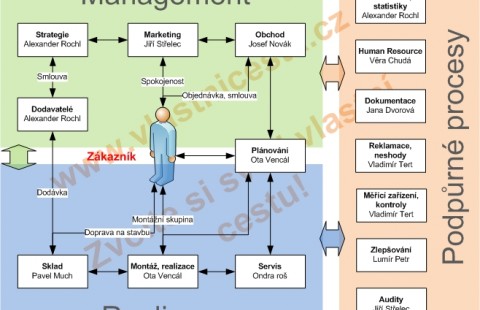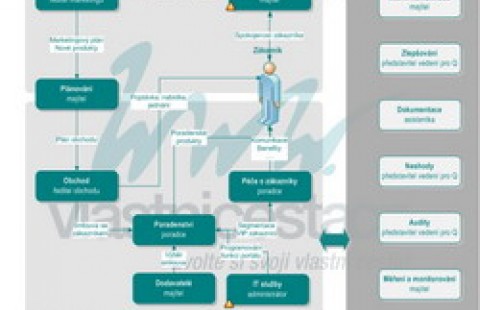The very fact that we can tell the organization´s hard side from the soft one and acknowledge their respective specifics does not mean we are able to integrate them so that they can form one synergically acting whole. Noway. In fact, it is often even the opposite: by eliminating human specifics we try to adapt the organization´s soft side to its hard side. This practice creates some sort of an organizational cripple, one whose chances to establish itself in competition with sound organizations - products of the holistic management - are relatively little.
Apart from other things, people have their dreams, wishes, aspirations and creative imagination which end in their somehow undetermined and not always targeted behaviour. Such behaviour does not fit in the hard organizational framework of processes, structures and strategies, defined through analytical methods which are designed to meet the desired results in the most effective way. I am going to explain the logic of this assertion in greater detail.
Determined behaviour
The most primitive type of behaviour is the determined behaviour. Going from different starting conditions, it will achieve different results, and from each such result you can trace back its exact cause. In other words: in the determined behaviour, there is an unequivocal corelation between the result (marked with the letter V) and the starting conditions (marked with the letter P).
If we specify exactly what people are supposed to do, we require them to behave in the determined way.What defines the result how defines the manner of realization, with a typical example being operators in the production process in which we adapt their behaviour to the behaviour of machines. We do not do it in reverse, as the machine - we are inclined to think, and rightly so - is comparatively inflexible: its input and output are defined, and it cannot pick and choose the way in which it prefers to achieve the result.
It was exactly this philosophy that the classical industrial era management at the turn of the 19th and the 20th centuries was based upon. It was to last until the 1970s or the 1980s. Admittedly, the results it achieved were phenomenal.
Yet at the turn of the 1970s and the 1980s, unequivocally, this approach alone turned out to be insufficient: under the changed circumstances, organizations which began breaking the rules of the classical management were establishing themselves successfully. Among other things, the target-oriented management was born and, before long, won recognition.
Implementation of the target-oriented management in organizations was facing no major problems. It was due to the fact that people are able to behave not just in the determined manner, but also in the goal-directed one.
Targeted (Goal-seeking) behaviour
Targeted behaviour adds another possibility to the ability to behave in a determined manner, which is that the given result or aim is achievable regardless of the conditions you start from.
In order to achieve this, clearly, a somewhat higher flexibility of behaviour is of the essence. In other words: what the worker is supposed to achieve is indeed still determined by somebody or somehow, yet the ways how to achieve that are up to the worker to choose. And exactly this is reflected in one golden managerial rule of that period: „Tell your workers what to do, not how to do it.“
Here we should remark that the ability to act in a targeted manner comes with something like a room thermoregulator: regardless of whether it is hot or cold outside, it maintains still the same room temperature. That is what it has been designed to do. However, it behaves with some flexibility: sometimes it will increase the temperature, at another time, conversely, it will decrease it. The fact we modify its target every now and then is irrelevant here.

Legal aspects of insolvency and reorganization

The Real | Interim Manager for Your Changes

Manager work model

Time management - making use of time effectively

Jak správně tvořit mapu procesů

Modelling and setting the processes and procedures - ISO 9001

Training - preparation of the SWOT analysis and strategy

Company Management System of Quality Step by Step - ISO 9001

Process map acc ISO 9001 - business offer
People are, nonetheless, endowed with another ability. The ability to behave purposefully.
Purposeful behaviour
Purposeful behaviour excludes neither targeted behavior nor determined behaviour, adding a little extra something into the bargain. The extra something is the ability to achieve dramatically different results while going from the same starting point. People quite clearly possess such an ability. For instance, you have someone get you milk, and they will get you rolls instead. Wouldn´t you kill that guy?
And this is precisely the domain of management: setting targets and, as can well be the case, processes, structures, strategies, watching what is going on, and eliminanting deviations from the standard.
Perfect mastery of the targeted behaviour makes the ultimate management dream come true. Thus, management achieves the defined and pedictable results. Yet the purposeful behaviour necessarily introduces major problems into the management mission, and, viewed from this perspective, it is undesirable and deserves to be eliminated.
Let me summarize it now: hopefully, it is clear by now that people´s behaviour is, by nature, neither purely determined nor fully targeted; they behave purposefully at times. I also hope it is evident that such behaviour does not fit in the rigid organizational framework of machines and thermoregulators which are designed to meet the defined results.
Let´s go, however, beyond the bounds of the above statement of fact. Viewed from another perspective, though, the purposeful behaviour may not be all that detrimental. The very opposite is true.
Just imagine what it would be like if you sent a technician to do some assembly work on your customer´s premises. Not only that he would do his work, but - in addition - he would bring in another, new contract worth several millions. Would not it be great?
The ability to behave purposefully is absolutely essential to develop new things and new approaches, as well as to exceed the established expectations.
With this ability, and with this ability only, one can achieve even unpredictable results, results that exceed the most daring of expectations, results the world has yet to see.
Managerial leadership
Unlike the managerial controlling which deals with predictable results, the ability to achieve unpredictable results rests with the managerial leadership. Maybe, doing them both in parallel is not all that bad. And, possibly, doing them both in such a way as the two activities do not inhibit but support each other.
In the 1920s, some managerial thinkers were becoming increasingly aware of the fact that
a) the targeted behaviour of employees alone represents a sizeable disadvantage in dealing with some important business matters, and
b) that the inborn human capacity can be taken advantage of, and employees can start behaving with even greater degree of flexibility than the aforesaid room thermometer.
Even seasoned managerial practitioners have now come to realize ever more increasingly that the road to outstanding results does not rest in elimination of the human factor, but in its development and utilization to the benefit of the organization. The common sense commands them to believe that excellence does not rest in elimianting the managerial control and returning to the period of total chaos either. Some already know, others are still just suspecting that the road to organizational excellence leads through integration of differing parts into one synergic whole.Therefore, no elimination, no dismemberment or just toleration, but the synergy of both.
So far only few corporations have succeeded in implementing this fundamental paradigm of the holistic management into the organizational practice. The managers do know how to distinguish between the hard and the soft organizational aspects, but, more often than not, they have not been able to distinguish between the specifics of their operation, that is, between the managerial controlling and the managerial leadership, thus standing no chance of integrating them into one holistic whole. They stand zero chance of creating a sound organization, for you cannot integrate something you cannot distinguish.
Examples are plentiful. Research carried out at several universities in the US and published in 2010, for instance, shows the distinctive orientation towards reaching of the goals, which is the absolute routine today, profoundly makes for:
- an increase in unprofessional behaviour,
- a distortion of hazardous preferences,
- corrosion of the oraganizational culture, and
- a decrease in the workers´ motivation.
Violence being committed is also evidenced by research conducted in 2000 by the International Organization of Work which concerned occupation-related mental disorders and states that about 10% of employees do suffer from depression, anxiety, stress or burn-out, with another 10% of workers being in for the trouble. The implications for the employer are clear: lower productivity, lower profit, higher costs of hiring and training substitute workers. In the US it accounts for the loss of 200 million work-days per annum, while in Germany it represents the production loss worth several billions of euros. Overall, it leads to lower tax revenues and higher expenditures on health care, too. We cannot really speak about healthy organizations, at least not in the majority of cases.
Somehow, by a rare coincidence (or would they be doing it purposefully???), the organizations that have progressed furthest in the field of synergic integration of different parts are exactly those organizations which boast the highest market value, reach the highest profits in their respective branches, and are the most sought-after employers.
They practise the holistic management.



